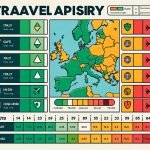Italy is a popular tourist destination known for its rich history, stunning landscapes, and world-renowned cuisine. However, in light of recent events, many travelers are left wondering: “What level travel advisory is Italy?”. Understanding the current state of travel in Italy is essential for anyone considering a trip to this beautiful country.
As with any international travel, it’s important to stay informed about travel advisories and their implications. This article will explore the current level of travel advisory for Italy, how it is determined, and the factors contributing to this advisory level. Additionally, we will discuss the impact of the travel advisory on travelers and tourism in Italy, as well as precautions and safety measures for those planning to visit at the current advisory level.
Whether you have a trip planned to Italy or are simply interested in staying informed about global travel conditions, understanding the current state of travel in Italy and how to navigate travel advisories is crucial. Let’s delve into what exactly the current travel advisory means for those considering a trip to Italy.
Understanding Travel Advisories
Travel advisories are issued by governmental authorities to provide guidance to their citizens about the safety and security of traveling to a particular destination. These advisories are based on a thorough assessment of various factors that may affect the safety of travelers, including political instability, natural disasters, terrorism, and health concerns such as pandemics. It is important for travelers to understand what these advisories mean and how they are determined in order to make informed decisions about their travel plans.
The level of a travel advisory indicates the perceived risk associated with travel to a specific country. The levels typically range from 1 (Exercise Normal Precautions) to 4 (Do Not Travel), with each level providing specific guidance for travelers. For Italy, the current travel advisory level is closely monitored by the U.S. Department of State and other international government agencies, which assess the situation in Italy based on various criteria before issuing or updating an advisory.
When determining the level of a travel advisory for Italy, factors such as crime rates, civil unrest, health risks, and potential terrorist threats are taken into consideration. Additionally, any ongoing conflicts or geopolitical tensions that may pose a risk to travelers are also assessed. By understanding how these factors contribute to the determination of the travel advisory level for Italy, travelers can better gauge the potential risks associated with their trip and take appropriate precautions.
Level of Travel Advisory for Italy
Italy is a popular destination for tourists from around the world, known for its incredible history, beautiful landscapes, and delicious cuisine. However, before planning a trip to Italy, it’s important to be aware of the current travel advisory level for the country. Understanding what level travel advisory is Italy can help travelers make informed decisions about their upcoming trips.
The current travel advisory level for Italy is determined by various factors, including the safety and security situation in the country, as well as any potential risks to travelers. It is essential to stay up-to-date with these advisories to ensure a safe and enjoyable trip to Italy. Here’s an overview of the current travel advisory level for Italy:
- Level 1: Exercise Normal Precautions
- Level 2: Exercise Increased Caution
- Level 3: Reconsider Travel
- Level 4: Do Not Travel
As of the latest update, Italy is currently at Level 3 – Reconsider Travel. This means that travelers should carefully consider the risks involved in visiting Italy and take necessary precautions before making any travel plans.
Factors contributing to this advisory level include but are not limited to political unrest, natural disasters, health concerns such as COVID-19, and potential threats to personal safety. It’s important for travelers to be aware of these factors and stay informed about any changes in the travel advisory level for Italy.
In light of this current advisory level for Italy, travelers should take certain precautions and safety measures when planning their trip. It’s crucial to stay informed about local conditions in Italy and follow any guidance or restrictions implemented by local authorities. Additionally, travelers should consider purchasing travel insurance that covers cancellations or disruptions due to unforeseen circumstances. By taking these precautions, travelers can help ensure a safer and more enjoyable experience in Italy despite the current advisory level.
Factors Contributing to the Current Travel Advisory Level for Italy
COVID-19 Situation
The COVID-19 pandemic has had a significant impact on travel advisories for Italy. The country was one of the first in Europe to be heavily affected by the virus, leading to strict lockdown measures and travel restrictions.
As the situation continues to evolve, the level of travel advisory for Italy is closely tied to the country’s ability to control and manage the spread of the virus. Factors such as vaccination rates, case numbers, and healthcare capacity are all taken into consideration when determining the current advisory level.
Crime and Safety Concerns
Aside from the pandemic, other factors contributing to Italy’s travel advisory level include crime rates and safety concerns. While Italy is generally a safe destination for tourists, certain areas may have higher instances of petty theft or scams targeting visitors. Travel advisories take into account these safety issues, particularly in popular tourist destinations, and provide guidance on how travelers can stay safe while visiting Italy.
Natural Disasters and Political Unrest
Italy is also prone to natural disasters such as earthquakes and flooding. These events can impact travel advisories, especially if they lead to infrastructure damage or pose risks to travelers’ safety. Additionally, political unrest or civil disturbances can also affect the travel advisory level for Italy. Instances of protests or demonstrations may lead to warnings for travelers to avoid certain areas or exercise caution during their visit.
As travelers consider visiting Italy, it’s important to stay informed about these factors and understand how they contribute to the current travel advisory level for the country. By staying informed and taking necessary precautions, visitors can still enjoy all that Italy has to offer while ensuring their safety during their trip.
Impact of the Travel Advisory on Travelers and Tourism in Italy
The impact of travel advisories on travelers and tourism in Italy is significant and multi-faceted. As one of the most popular tourist destinations in the world, Italy relies heavily on tourism for its economy. The issuance of a travel advisory can have far-reaching consequences on both travelers and the country’s tourism industry.
Effect on Travel Plans
When a travel advisory is issued for a destination such as Italy, it often leads to a decrease in the number of tourists visiting the country. Travelers who had been planning trips to Italy may reconsider or cancel their plans due to safety concerns or potential disruptions caused by the advisory. This decline in tourist numbers can have significant economic repercussions for businesses that rely on tourism, such as hotels, restaurants, and tour operators.
Financial Impact
The impact of a travel advisory on tourism in Italy extends beyond just the travelers themselves. The overall economy of the country suffers as a result of decreased tourist spending. This can lead to job losses and financial hardship for those employed in the tourism sector. Additionally, local businesses that cater to tourists may experience a decline in revenue, further exacerbating the economic impact.
Long-Term Effects
In addition to immediate financial repercussions, travel advisories can also have long-term effects on a destination’s reputation as a safe and desirable place to visit. If travelers continually receive warnings about safety concerns in Italy, it could deter them from ever considering it as a future travel destination. Rebuilding trust and enticing tourists back to Italy after a prolonged period of negative advisories can be challenging, even after safety concerns have been resolved.
Precautions and Safety Measures for Traveling to Italy at the Current Advisory Level
Italy, a beautiful country known for its rich history, delicious cuisine, and stunning landscapes, is currently under a level 3 travel advisory. This means that individuals should reconsider travel to Italy due to the widespread community transmission of COVID-19 and the presence of variant strains of the virus.
While this advisory may deter some travelers from visiting Italy, it is important to understand that there are still precautions and safety measures that can be taken to ensure a safe and enjoyable trip.
One of the most crucial precautions for traveling to Italy at the current advisory level is to stay informed about the COVID-19 situation in the country. This includes regularly checking for updates on travel advisories, restrictions, and requirements for entry. Additionally, travelers should familiarize themselves with the local guidelines and regulations in place in different regions of Italy, as these may vary.
It is also essential for travelers to adhere to recommended safety measures such as wearing masks in crowded or indoor settings, practicing good hand hygiene, maintaining physical distance from others, and avoiding large gatherings. Furthermore, individuals should consider getting vaccinated before their trip if they have not already done so, as vaccination can provide an added layer of protection against COVID-19.
Overall, while traveling to Italy at the current advisory level may require extra planning and caution, it is still possible to have a fulfilling experience while staying safe and healthy. By staying informed about the situation in Italy and following recommended precautions and safety measures, travelers can make informed decisions and minimize the potential risks associated with their trip.
Updates and Changes to the Travel Advisory
When planning any trip, it is essential to stay informed about the current travel advisories for your destination. This is especially important for a country like Italy, which has seen changes in its travel advisory levels due to various factors. To ensure that you have the latest information before traveling to Italy, here are some key ways to stay informed about updates and changes to the travel advisory:
Subscribe to Travel Advisory Alerts
Stay up to date with the latest travel advisories for Italy by subscribing to alerts from reputable sources such as the U.S. Department of State or the World Health Organization. These alerts will provide you with real-time information about any changes in the travel advisory level, as well as specific details about safety concerns and precautions for travelers.
Monitor News and Official Websites
Keep an eye on news updates and official websites of government agencies in both your home country and Italy. These sources often release statements regarding any changes in travel advisories, along with explanations for the reasons behind these changes. It’s important to verify information from multiple credible sources before making any decisions about your trip.
Consult With Travel Experts and Agencies
If you’re unsure about the current travel advisory level for Italy or need clarification on specific safety concerns, consider consulting with travel experts or agencies specializing in Italian tourism. These professionals can offer personalized advice based on the latest information and help you make informed decisions about your travels.
By staying informed through these channels, you can navigate any updates or changes to the travel advisory for Italy and make well-informed decisions for your trip. Remember that staying aware of these advisories is crucial for prioritizing your safety and enjoyment while traveling abroad.
Conclusion
In conclusion, understanding the level of travel advisory for Italy is crucial for anyone planning a trip to the country. As of now, Italy has been placed under a Level 3 travel advisory by the U.S. Department of State, which advises travelers to reconsider their trip due to COVID-19. This means that while travel is not completely restricted, there are significant risks and precautions that need to be taken into consideration.
Travel advisories are determined based on a variety of factors, including current health and safety conditions, political unrest, natural disasters, and more. For Italy, the Level 3 advisory is primarily due to the ongoing impact of the COVID-19 pandemic. It’s important for travelers to stay informed about any updates or changes to the travel advisory, especially as conditions may improve or worsen over time.
While the Level 3 travel advisory for Italy may deter some travelers, it’s still possible to visit the country with careful planning and adherence to safety measures. This includes staying updated on local regulations and restrictions, following recommended health guidelines, and being prepared for potential disruptions in travel plans. Ultimately, navigating travel advisories requires making informed decisions based on current conditions and taking necessary precautions for a safe and enjoyable trip to Italy.
Frequently Asked Questions
What Is the Current Travel Advisory Level for Italy?
The current travel advisory level for Italy is Level 3, which means to reconsider travel. This suggests that there are significant risks present in the country, and travelers should carefully assess their plans before visiting.
What Are Level 4 Travel Advisory Countries?
Level 4 travel advisory countries are those with a “Do Not Travel” warning, indicating the highest level of safety and security risk. These countries may have ongoing conflict, high crime rates, or other serious threats to travelers’ safety.
What Is a Level 3 Travel Advisory?
A Level 3 travel advisory advises travelers to reconsider their plans due to potential risks in the country. This could be due to factors such as civil unrest, natural disasters, or other safety concerns that make traveling to the country potentially risky.

I’m a passionate traveler, writer, and Italophile. My fascination with Italy’s history, art, and culture has led me on countless adventures across the Italian landscape. Through “I Live Italy,” I share my love for this extraordinary country and aims to inspire others to explore its boundless beauty.





